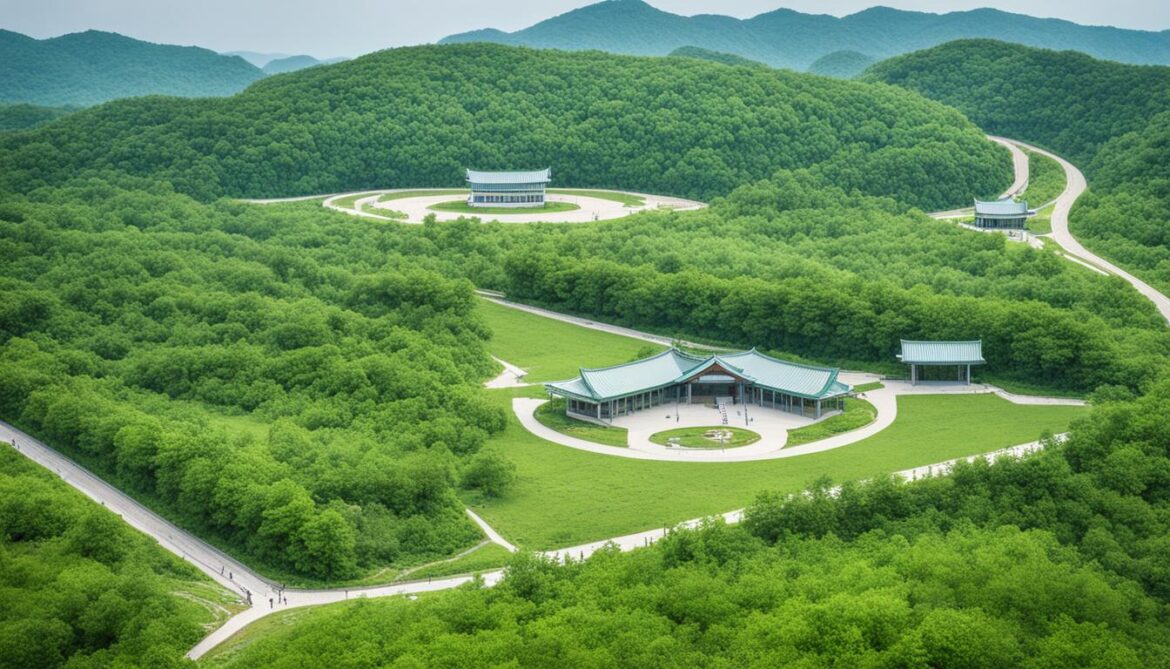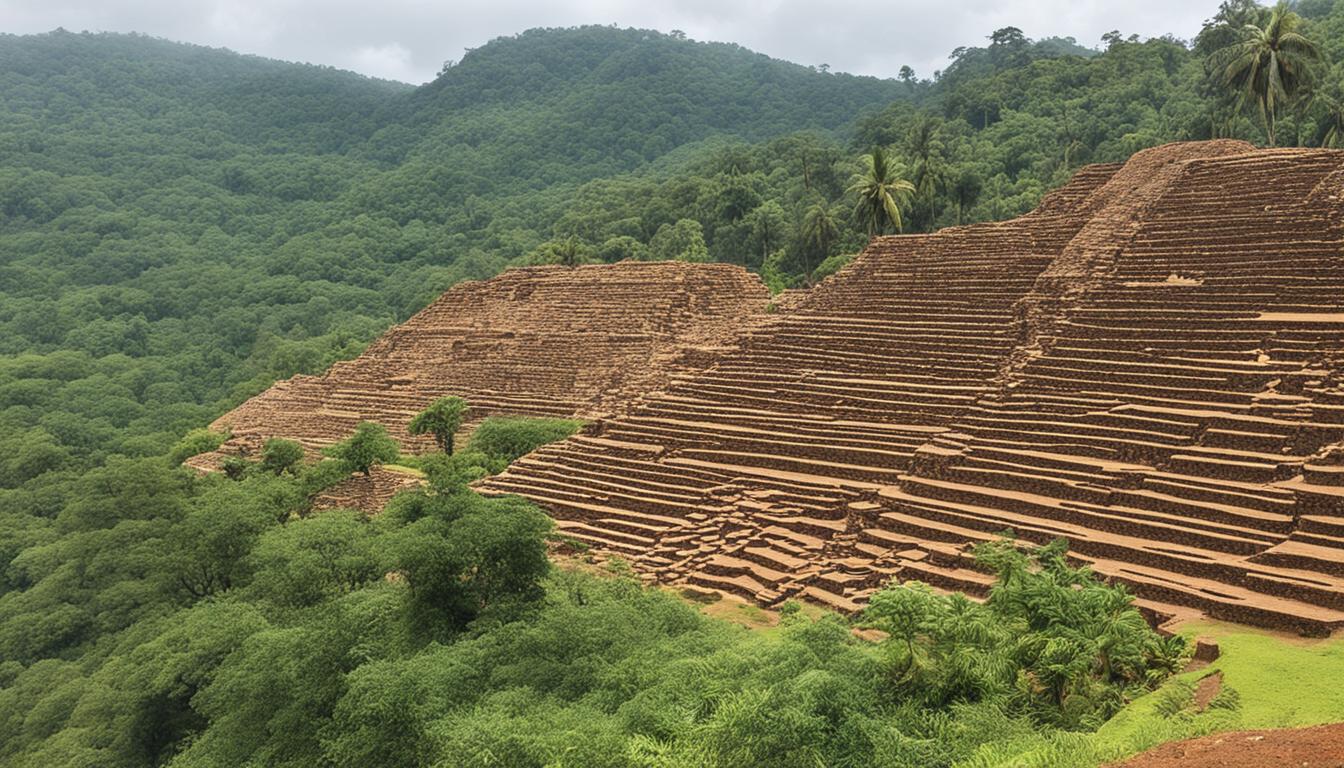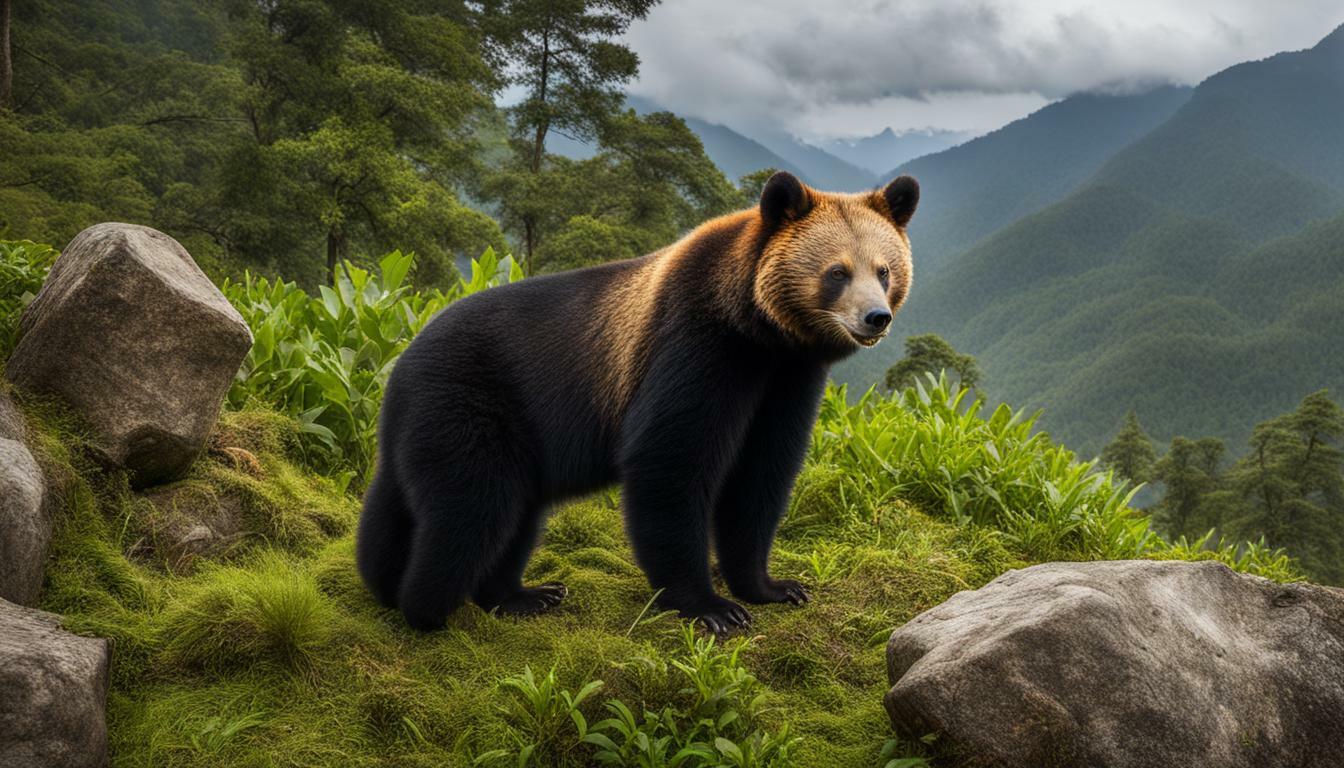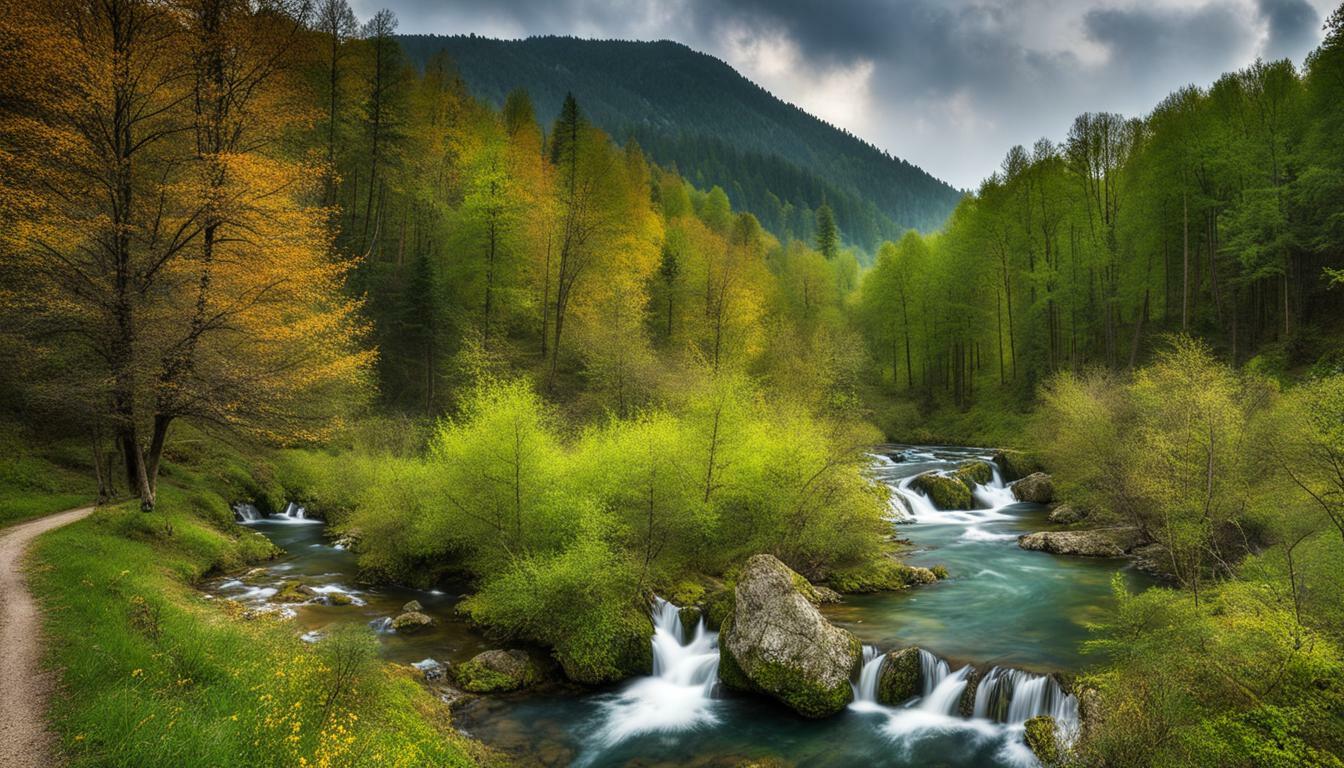North Korea Sacred Natural Sites and Biodiversity
Did you know that North Korea is home to some of the most unique and pristine natural sites in the world? These sacred sites not only hold immense cultural significance but also play a crucial role in biodiversity conservation and environmental preservation. From towering mountains to lush forests, North Korea’s natural heritage is a hidden gem that deserves our attention.
Key Takeaways:
- North Korea’s sacred natural sites are valuable for both cultural heritage preservation and biodiversity conservation.
- The involvement of indigenous communities in conservation efforts is crucial for sustainable resource management.
- Ecosystem restoration plays a vital role in the conservation of biodiversity hotspots in North Korea.
- Mt. Baekdu, one of North Korea’s sacred sites, is not only a cultural icon but also a biodiverse hotspot.
- The preservation of the demilitarized zone as a nature reserve poses both challenges and opportunities for environmental conservation and peacebuilding.
Importance of Sacred Natural Sites for Biodiversity Conservation.
Sacred natural sites play a crucial role in biodiversity conservation and maintaining the ecological balance. These sites provide sanctuaries for rare and endangered species and contribute to the preservation of traditional knowledge related to the environment. In North Korea, the protection and preservation of sacred natural sites are of utmost importance for the conservation of biodiversity and the safeguarding of traditional knowledge.
The value of sacred natural sites lies in their ability to provide refuge for a diverse range of plant and animal species. These sites act as safeguards for rare and endangered species that are threatened by environmental changes and human activities. By preserving and protecting these sites, we can ensure the survival of these species and maintain the delicate balance of ecosystems.
“Sacred natural sites not only conserve biodiversity but also carry immense cultural significance. They are a testament to our ancestors’ wisdom and their deep connection with the natural world.” – Dr. Lee Ji-hyun, Environmental Scientist
In North Korea, efforts are being made to prioritize the protection and preservation of sacred natural sites. These measures aim to ensure the conservation of biodiversity and the sustainable management of natural resources. By safeguarding these sites, North Korea is taking a proactive approach to environmental conservation and demonstrating its commitment to the preservation of cultural heritage.
The protection of sacred natural sites also contributes to the preservation of traditional knowledge. Indigenous communities, who have coexisted with these sites for generations, hold valuable insights and practices that promote sustainable resource management. Their involvement in conservation efforts ensures that traditional knowledge is passed down and continues to inform environmental practices.
The Role of Sacred Natural Sites in Ecosystem Restoration
In addition to their value in biodiversity conservation, sacred natural sites also play a crucial role in ecosystem restoration. These sites often possess unique habitats and microclimates that support the growth of diverse plant species. By restoring and rehabilitating these sites, we can revive damaged ecosystems and create healthier environments for both flora and fauna.
The restoration of sacred natural sites not only benefits the local biodiversity but also provides opportunities for scientific research and the discovery of new species. The preservation of these sites allows scientists to study and understand the complex relationships between species and their habitat, contributing to our knowledge of ecological systems and aiding future conservation efforts.
Overall, the protection, preservation, and restoration of North Korea’s sacred natural sites are crucial for biodiversity conservation, the preservation of traditional knowledge, and the sustainable management of natural resources. By recognizing the importance of these sites and investing in their conservation, North Korea is taking a significant step towards a more environmentally sustainable future.
Conservation Efforts in North Korea.
North Korea is committed to the conservation of its sacred natural sites and biodiversity. These efforts are aimed at protecting the country’s environmental heritage while ensuring the sustainable management of its resources. In addition to environmental conservation, North Korea recognizes the importance of preserving its cultural heritage and involving indigenous communities in conservation initiatives. The restoration of ecosystems is also a priority to maintain the balance of the natural environment.
One of the key aspects of conservation in North Korea is the preservation of cultural heritage. The country recognizes that its sacred natural sites are not only important for their ecological value but also for their cultural significance. By safeguarding these sites, North Korea aims to protect the traditional knowledge and practices associated with them, ensuring that they are passed down to future generations.
An integral part of the conservation efforts in North Korea is the involvement of indigenous communities. These communities have a deep connection to the land and possess valuable traditional knowledge about the environment. By engaging indigenous communities in conservation initiatives, North Korea can tap into their wisdom and expertise, enhancing the effectiveness of conservation measures and promoting a sense of ownership and responsibility among local people.
Another crucial aspect of conservation in North Korea is ecosystem restoration. The country recognizes the importance of maintaining the health and vitality of its ecosystems. Efforts are being made to restore degraded ecosystems and ensure the survival of plant and animal species. Through measures such as reforestation and habitat restoration, North Korea aims to create a more sustainable and resilient environment.
Conservation efforts in North Korea are holistic, encompassing environmental, cultural, and social aspects. By integrating environmental conservation, cultural heritage preservation, indigenous community involvement, and ecosystem restoration, North Korea is taking a comprehensive approach to protect its sacred natural sites and biodiversity.
Conservation Initiatives in Action
To illustrate the conservation efforts in North Korea, here are some key initiatives:
- Cultural Heritage Preservation: North Korea has established regulations and guidelines to protect its cultural heritage, including sacred natural sites. These measures promote the preservation of traditional knowledge and practices, ensuring the continuity of cultural heritage.
- Indigenous Community Involvement: North Korea actively engages indigenous communities in the decision-making processes related to conservation. This involvement ensures that their perspectives and knowledge are taken into account, leading to more sustainable and culturally sensitive conservation practices.
- Ecosystem Restoration: North Korea has implemented large-scale reforestation projects to restore degraded ecosystems. These projects focus on planting native tree species and rehabilitating habitats to create healthier and more diverse ecosystems.
By implementing these initiatives, North Korea is making significant progress in environmental conservation, cultural heritage preservation, indigenous community involvement, and ecosystem restoration. These efforts contribute to the long-term sustainability of North Korea’s sacred natural sites and biodiversity.
Conservation Achievements
The conservation efforts in North Korea have yielded positive results, demonstrating the effectiveness of the initiatives. Some notable achievements include:
| Conservation Achievement | Description |
|---|---|
| Protected Area Expansion | North Korea has expanded its network of protected areas, encompassing a greater range of sacred natural sites and biodiversity hotspots. This expansion provides increased protection for these valuable areas. |
| Species Recovery | Through dedicated conservation efforts, North Korea has successfully aided in the recovery of several endangered plant and animal species. These efforts have prevented the extinction of these species and contributed to the overall biodiversity conservation. |
| Community Engagement | The involvement of indigenous communities in conservation initiatives has led to a stronger sense of environmental stewardship and community ownership. Local communities are actively participating in the preservation of their natural and cultural heritage. |
These achievements highlight the positive outcomes of North Korea’s conservation efforts and serve as inspiration for further action in protecting the country’s sacred natural sites and biodiversity.
Mt. Baekdu: A Sacred and Biodiverse Site.
One of the most renowned sacred natural sites in North Korea is Mt. Baekdu. This mountain is not only considered a sacred site but is also rich in biodiversity. It is home to various endangered plants and animals, including the Asiatic black bear, leopard, and Eurasian lynx. Mt. Baekdu is also the starting point of the Baekdu Daegan, a chain of ridges and peaks that stretches through the Korean Peninsula. Its ecological significance and cultural importance make it a significant hotspot for biodiversity conservation.

With its majestic landscape and diverse ecosystem, Mt. Baekdu is a testament to the country’s commitment to preserving its sacred natural sites and protecting its biodiversity. The mountain’s cultural significance to the Korean people adds to its ecological value, making it a site of great importance for both conservationists and historians.
“Mt. Baekdu is not just a mountain; it is a symbol of our heritage and a sanctuary for wildlife. We must continue our efforts to protect and preserve this sacred site for future generations.” – Kim Young-sook, Environmental Activist
The biodiversity found on Mt. Baekdu is a reflection of the country’s commitment to sustainable resource management and the preservation of traditional knowledge. The conservation of this sacred and biodiverse site is a priority for North Korea in its ongoing efforts to safeguard its natural heritage.
The Significance of Mt. Baekdu’s Biodiversity
The biodiversity found on Mt. Baekdu plays a vital role in the overall health of the ecosystem. The presence of endangered species indicates the mountain’s importance as a refuge for rare and threatened wildlife. By protecting the biodiversity of Mt. Baekdu, North Korea contributes to the global conservation efforts and helps maintain the delicate balance of nature.
Furthermore, the rich biodiversity of Mt. Baekdu is essential for scientific research and ecological studies. Researchers and scientists have the opportunity to study unique plant and animal species, gaining valuable insights into their behavior and biology. This knowledge can then be used to inform conservation strategies and ensure the preservation of biodiversity hotspots like Mt. Baekdu.
Preserving Mt. Baekdu for Future Generations
The preservation of Mt. Baekdu requires ongoing efforts from both local and international stakeholders. With its cultural and ecological significance, the mountain serves as a shining example of the need for sustainable resource management and biodiversity conservation.
North Korea’s commitment to protecting Mt. Baekdu’s sacred natural site and its biodiversity serves as a model for other countries facing similar challenges. By promoting the involvement of local communities, implementing effective conservation strategies, and fostering international collaboration, Mt. Baekdu can continue to thrive as a sacred and biodiverse site for generations to come.
North Korea’s Efforts to Enlist Mt. Baekdu as a UNESCO Global Geopark.
North Korea has been actively seeking the enlistment of Mt. Baekdu as a UNESCO global geopark. The country recognizes the mountain’s unique geological features, rich biodiversity, and cultural significance. By submitting an application to UNESCO, North Korea aims to gain international recognition for Mt. Baekdu’s outstanding universal value and promote its conservation and sustainable tourism development.
The UNESCO global geopark certification would highlight Mt. Baekdu’s exceptional geological formations, which include volcanic craters, calderas, and lava flows. The mountain’s geological history spans millions of years, offering valuable insights into the Earth’s dynamic processes. This recognition would not only contribute to scientific research but also raise awareness about the importance of geological heritage.
Moreover, Mt. Baekdu is home to a diverse range of plant and animal species, making it a significant hotspot for biodiversity conservation. The mountain’s forests provide habitats for rare and endangered species, including the Amur leopard, Manchurian reed warbler, and Korean spruce. UNESCO global geopark status would not only safeguard these species but also support efforts to restore and conserve their habitats.

The cultural significance of Mt. Baekdu cannot be overlooked. The mountain holds great historical and mythical importance in Korean culture. It is considered a sacred site and is featured in various folklore and legends. By promoting Mt. Baekdu as a UNESCO global geopark, North Korea aims to protect and celebrate the cultural heritage associated with the mountain, ensuring its preservation for future generations.
Benefits of UNESCO Global Geopark Certification
Becoming a UNESCO global geopark would bring numerous benefits to Mt. Baekdu and North Korea. Firstly, it would enhance the international visibility of Mt. Baekdu as a unique and significant natural site, attracting more tourists and researchers from around the world. This would contribute to the local economy and promote sustainable tourism development in the region.
UNESCO global geopark status would also provide access to international funding and collaboration opportunities, enabling North Korea to implement effective conservation and management strategies for Mt. Baekdu. The certification would ensure the long-term preservation of the mountain’s exceptional geological, ecological, and cultural values.
Furthermore, UNESCO global geopark designation would foster educational opportunities and raise awareness about the importance of geodiversity, biodiversity, and cultural heritage. It would encourage the engagement of local communities in the stewardship of Mt. Baekdu, promoting a sense of pride and responsibility among the inhabitants.
Challenges in Preserving the Demilitarized Zone as a Nature Reserve.
The demilitarized zone (DMZ) between North and South Korea has unintentionally become a de facto nature reserve due to its lack of human activity. This unique natural environment faces numerous challenges in terms of its preservation as a nature reserve.
Development pressures in the surrounding areas threaten the delicate ecological balance of the DMZ. The demand for infrastructure and urbanization poses risks to the natural habitats and species within the zone. Deforestation, in particular, not only fragments the landscape but also diminishes the overall biodiversity in the region.
Furthermore, the presence of landmines, which were laid during wartime, presents a significant obstacle to environmental conservation efforts. Not only do these explosives pose a threat to human safety, but they also hinder the natural movement of wildlife and disrupt ecological processes.
Environmentalists and conservation organizations are working tirelessly to mitigate these challenges and protect the fragile ecosystem of the DMZ. Efforts are underway to raise awareness about the importance of the region’s biodiversity and advocate for stricter regulations and enforcement to prevent further degradation. Collaboration between North and South Korea, as well as international support, is crucial in overcoming these obstacles and preserving the DMZ as a nature reserve.

The Role of the DMZ Forum in Preserving the DMZ as a Nature Reserve.
The DMZ Forum, founded by Ke Chung Kim, plays a vital role in the preservation of the demilitarized zone (DMZ) as a nature reserve. This organization aims to protect the unique natural beauty and biodiversity of the DMZ, emphasizing its importance as a sacred natural site and a valuable ecological treasure.
Supported by global figures such as Nelson Mandela and Kofi Annan, the DMZ Forum organizes annual conferences that bring together experts, conservationists, and policymakers to discuss and develop strategies for the preservation of the DMZ. These conferences serve as platforms to exchange knowledge and raise awareness about the significance of the DMZ as a nature reserve.
“The DMZ Forum is committed to safeguarding the DMZ and its rich natural heritage for future generations to appreciate and cherish. Our collective efforts and shared vision are vital in the face of numerous challenges,” said Ke Chung Kim, Founder of the DMZ Forum.
However, engaging both North and South Korea in conservation efforts poses significant challenges. The political tension and lack of diplomatic relations between the two countries hinder seamless cooperation and the implementation of conservation measures. Despite these obstacles, the DMZ Forum remains committed to its mission of preserving the DMZ as a nature reserve.

The Environmental Significance of the DMZ.
The Demilitarized Zone (DMZ) in North Korea holds immense environmental significance, serving as a haven for endangered plant and animal species. This unique area benefits from its lack of human activity and the absence of industrial development, creating an ideal habitat for various species that are facing the risk of extinction.
Among these endangered species, the DMZ provides a refuge for iconic animals such as the Asiatic black bear, leopard, and numerous migratory birds. The pristine landscape and undisturbed environment make the DMZ an important conservation area for the protection of these vulnerable creatures.

The preservation of the DMZ is crucial not only for the survival of these endangered species but also for the overall conservation of biodiversity in the region. The absence of human interference and the intact natural ecosystems within the DMZ contribute to the maintenance of ecological balance and the preservation of delicate ecosystems.
Efforts to safeguard the DMZ and its endangered species require a collaborative approach, involving both governmental and non-governmental organizations dedicated to environmental conservation. Through scientific research, habitat restoration, and monitoring programs, conservationists aim to ensure the long-term protection and survival of these species within the DMZ.
Furthermore, the presence of these endangered species in the DMZ highlights the urgent need for global awareness and action to protect and restore ecosystems worldwide. By recognising the environmental significance of the DMZ and the role it plays in biodiversity conservation, we can inspire greater efforts towards sustainable development and the preservation of our planet’s natural heritage.
Future Challenges and Opportunities for the DMZ.
The future of the DMZ as a nature reserve presents both challenges and opportunities for North Korea’s sacred natural sites and biodiversity preservation. The development pressures from both North and South Korea pose a threat to the DMZ’s ecological integrity and its potential as a valuable natural resource. However, amidst these challenges, there are also promising opportunities for cross-border cooperation and the sustainable development of tourism in the region.
By addressing the development pressures, North Korea can ensure the long-term preservation of the DMZ’s unique natural heritage. It is crucial to implement comprehensive planning strategies that prioritize sustainable practices and strike a balance between development and conservation. By promoting responsible tourism, the DMZ can generate economic benefits while minimizing negative environmental impacts.

Collaboration between North and South Korea is key to realizing the potential of the DMZ as a symbol of peace and a shared natural resource. Joint preservation efforts can strengthen diplomatic relations and pave the way for a united commitment to conservation. By engaging in constructive dialogue and cooperation, both countries can work towards a common goal of safeguarding the DMZ’s rich biodiversity and cultural heritage.
“The preservation of the DMZ requires concerted efforts from both North and South Korea, as well as the international community. It presents an opportunity for peaceful collaboration and conservation, showcasing the DMZ’s significance beyond political boundaries.”
Given the unique geopolitical context of the DMZ, successful preservation efforts also necessitate the involvement of international stakeholders. International organizations, conservationists, and researchers can provide expertise, funding, and support towards ensuring the sustainable future of the DMZ as a nature reserve.
| Challenges | Opportunities |
|---|---|
|
|
|
|
With the collective efforts of all stakeholders, the DMZ has the potential to become a model for sustainable development, peacebuilding, and biodiversity conservation. By preserving this unique natural site, North Korea can contribute to the global efforts of environmental conservation and inspire future generations to prioritize the protection of natural heritage.
Potential for Cooperation and Conservation in the DMZ.
The preservation of the DMZ as a nature reserve requires cross-border cooperation and collaboration between North and South Korea, along with the involvement of international stakeholders. By working together, the two Koreas can protect the DMZ’s unique natural heritage and promote peace through environmental conservation.
North-South Bike Path and Eco-Park: Building Confidence and Collaboration
Efforts to establish a north-south bike path and eco-park have been proposed as confidence-building measures and opportunities for collaboration between North and South Korea. These initiatives would not only encourage sustainable tourism but also create a shared space for environmental education and conservation awareness.
“The potential for the DMZ to bridge divides and foster peace through environmental cooperation is immense. By working together to protect this natural treasure, North and South Korea can build trust and promote a shared vision of conservation and peace.” – Park Ji-hoon, Environmental Activist
International Support for Conservation Efforts
International stakeholders play a crucial role in supporting and facilitating cross-border conservation efforts in the DMZ. Organizations such as UNESCO, environmental NGOs, and diplomatic entities can provide expertise, funding, and diplomatic channels to foster cooperation, promote sustainable development, and ensure the long-term preservation of the DMZ as a nature reserve.
Shared Responsibility for Environmental Conservation
Preserving the DMZ as a nature reserve requires a shared responsibility and commitment to environmental conservation from both North and South Korea. Through joint research, monitoring, and management efforts, the two countries can work towards a common goal of protecting the unique biodiversity and natural habitats found within the DMZ.
| Opportunities | Challenges |
|---|---|
| Cross-border research and monitoring programs | Political tensions and lack of trust |
| Collaborative habitat restoration projects | Development pressures and urbanization |
| Sustainable tourism development | Presence of unexploded landmines |
| Environmental education and awareness programs | Securing funding for conservation initiatives |
By addressing these challenges and seizing the opportunities for cooperation, North and South Korea can demonstrate their commitment to environmental stewardship, promote peace-building efforts, and safeguard the DMZ’s ecological integrity for future generations.

The DMZ Peace Park symbolizes the potential for peace and conservation in the Korean Peninsula.
Conclusion
North Korea’s sacred natural sites and biodiversity are invaluable treasures that deserve our utmost attention and protection. These sites not only contribute to the conservation of our environment but also play a vital role in preserving our cultural heritage for generations to come. The ongoing efforts to safeguard these sites involve sustainable resource management, active participation of indigenous communities, and the restoration of ecosystems.
The challenges faced in preserving the demilitarized zone as a nature reserve emphasize the significance of cross-border cooperation and collaboration. It is essential for North and South Korea to join hands and work together to ensure the long-term conservation of their shared natural heritage. By uniting their efforts, they can overcome the obstacles and seize opportunities for preserving and promoting biodiversity in the region.
Conservation and cultural heritage preservation go hand in hand, and we must continue to strive for their harmonious integration. North Korea’s commitment to protecting and preserving its sacred natural sites is a testament to their recognition of the importance of our natural and cultural legacy. Let us all contribute to this noble cause by raising awareness and supporting these conservation initiatives. Together, we can make a difference and safeguard North Korea’s sacred natural sites and biodiversity for the benefit of future generations.








